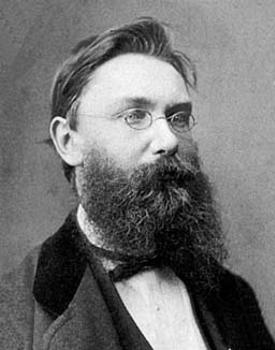German mathematician
Biographical Information
| Name: | Alfred Clebsch |
|---|---|
| Full name: | Rudolf Friedrich Alfred Clebsch |
| Born on | 19 January 1833 in Kaliningrad, Kaliningrad Oblast, Northwestern Federal District, Russia, Europe |
| Deceased on | 7 November 1872 in Göttingen, Göttingen (Kreis), Lower Saxony, Germany, Europe |
Short biography of Alfred Clebsch
The son of a regimental doctor, Alfred Clebsch attended grammar school and in 1850 began studying at the University of Königsberg, where his studies in mathematics and physics under Franz Ernst Neumann (1798–1895), Friedrich Julius Richelot (1808–75) and Ludwig Otto Hesse (1811–74) were very successful. He passed his state examinations in mathematics and physics, and Neumann supervised his doctorate (a dissertation on the motion of an ellipsoid in an incompressible fluid [Clebsch, 1854]). Clebsch subsequently attended the teacher training college under the directorship of Karl Heinrich Schellbach (1805–92), which was associated with the Friedrich Wilhelm Grammar School in Berlin, and afterwards worked at various schools in Berlin as a mathematics teacher. He wrote his habilitation thesis in 1858 at the Berlin University for Mathematical Physics. It was in that same year that he was appointed professor of analytical mechanics at Karlsruhe Polytechnic. In his book Theorie der Elasticität fester Körper [1862], Clebsch manages to achieve a synthesis between the second-order theories of Saint-Venant [Saint-Venant, 1855 & 1856] and Kirchhoff [Kirchhoff, 1858], and to develop these further. And he presents Kirchoff ’s plate theory on a wider mathematical footing thanks to his masterly differential geometry approach – a method that for Hermann Aron (1845–1913) would become a model for the first systematic treatment of elastic shells [Aron, 1874]. The book also contains Clebsch’s fundamental ideas for the displacement method , which have been acclaimed by Zienkiewicz and Samuelsson [Zienkiewicz, 2004, p. 4; Samuelsson & Zienkiewicz, 2006, p. 150]. Saint-Venant was so enthusiastic about this book that he and Alfred Flamant (1839–1914) translated it into French and added a valuable commentary [Clebsch, 1883]; a reprint appeared in 1966 [Clebsch, 1966]. But the engineering community ignored his book on elastic theory. Clebsch was appointed professor of mathematics at the University of Gießen in 1863, whereupon he shifted his scientific interests to pure mathematics – five years later he was appointed professor of pure mathematics at the University of Göttingen. It was in that same year that he founded the journal Mathematische Annalen together with Carl Gottfried Neumann (1832–1925). Unfortunately, Clebsch died of diphtheria at the age of just 39.
Main contributions to structural analysis:
Analytische Mechanik: nach Vorträgen, geh. An d. polytechn. Schule Carlsruhe, lithographiert [1859/1]; Elementar-Mechanik: nach Vorträgen, geh. An d. polytechn. Schule Carlsruhe von 1858 –1859, lithographiert [1859/2]; Theorie der Elasticität fester Körper [1862]; Théorie de l’élasticité des corps solides de Clebsch [1883]
Source: Kurrer, Karl-Eugen The History of the Theory of Structures, Wilhelm Ernst & Sohn Verlag für Architektur und technische Wissenschaften GmbH, Berlin (Deutschland), ISBN 3-433-01838-3, 2008; p. 722
Relevant Publications
- (2018): The History of the Theory of Structures. Searching for Equilibrium. 2nd edition, Wilhelm Ernst & Sohn Verlag für technische Wissenschaften, Berlin (Germany), ISBN 978-3-433-03229-9, pp. 981.
- About this
data sheet - Person-ID
1009709 - Published on:
15/05/2013 - Last updated on:
22/07/2014




